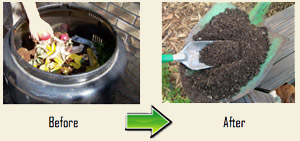What Can You Compost?
- Hay and straw
- Fresh yard trimmings/grass
- Dried yard trimmings/leaf litter
- Fruits and vegetables
- Coffee grounds and filters
- Eggshells and tea bags
- Fireplace ashes
- Hair and fur
- Paper, shredded newspaper, cardboard rolls and sawdust
What Cannot Be Composted
- Dairy products
- Fat, grease, oil, and lard
- Plastic or polyester
- Overly salty or sugary food products
- Coal, coal ash and barbeque coals
- Meat, bones, and fish
What Is Composting?
Compost is soil produced through the breakdown of organic material such as food and lawn waste.

Benefits
- Cheaper than buying top soil or mulch from a store
- Reduce the need for watering gardens or purchasing fertilizers
- Extends municipal landfill life by diverting organic material
- Save on disposal costs
- More environmentally friendly way to dispose of leaves and yard trimmings
Free Composting Methods
Dig a Hole
Dig a small hole and fill with mixture of green and brown material, Cover the hole and in the spring you can plant above these to help grow healthy plants.
Pile
This method requires a fair deal of maintenance. It is best to have an 'organized' pile of brown and green sources. Layering the material is best, but they can be mixed with good results as well.
Bin
The goal is to contain the compost. You are able to throw the compostable materials into the bin and turn roughly twice a month. You can use bins, concrete blocks, wood pallets, etc.
Note
Both pile and bin methods need to be covered when it rains to keep out extra water. The compost needs to be moist but not soggy. A good way to tell if there is too much moisture is if you can squeeze out water.
Ratio
To manage a good compost pile there is a certain ratio of brown to green materials that needs to be maintained. Keeping this ratio in mind while managing your compost will result in a pile that does not smell and breaks down faster, all with less effort from you. This is done by having more, a lot more, brown material than green. While it is often recommended that the compostable materials be mixed at 30 parts brown to 1 part green, it is more of an art than a science and you will get to know what your pile's needs as you continue to work with it.
Smell
If a smell develops it most likely is due to the fact that there is more green material in the compost. To fix this try to add more brown material such as paper. When it rains, try to cover the bin with a tarp or plastic bags, anything to help keep the water out. If too much water gets into the pile it can create a smell.
Things To Watch Out For
Low airflow - add material that will allow airflow through the compost bin or pile. You can increase airflow with the addition of large sticks in the middle of the pile to create space.
Ways To Make It Look Nice
- Keep the compost by the garden area. This also cuts down on how far you need to transport the material.
- Dig a hole which is invisible.
- Mixing the dig a hole method with another method will help keep the compost pile small and less noticeable. There will also be less material to tend, making for faster decomposition.
Before Digging
Call to locate buried utility lines: Call PA One Call at 811 or visit the PA One Call web site.

